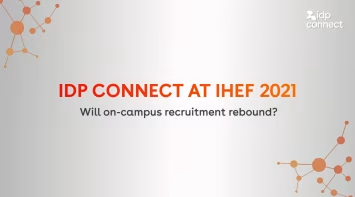What markets catch your eye today? When deciding where to spend your recruitment and marketing dollars, there are many variables to evaluate. From your institution’s history in certain countries (alumni, current students, institutional partnerships, etc.), macro-trends in international student mobility, the development of appropriate messaging campaigns, type of desired presence (in-person, 3rd party, or virtual), to an analysis of available data, you have much to consider.
Recent history
Brazil represents the largest market for prospective U.S.-bound international students in South America, and has done so since before the turn of the century. In fact, Open Doors Reports since at least 1999 have had Brazil no lower than 14th in their annual top sending countries lists. Aside from two significant drops in 2015-16 and 2016-17 when the Brazil Scientific Mobility Program or BSMP (2011-2016) ended, Open Doors had Brazil on a continual upward trajectory. As their economy developed so to did Brazilians thirst for an overseas education. Since the two down years after BSMP wrapped up, Brazil rebounded nicely in the 2017-18 Open Doors Report to over 14,620 (up 11.7%), well above the 8,777 enrolled pre-BSMP in 2010-11.
While the waves of BSMP students certainly boosted ESL program populations for several years, their impact was fairly limited as their scholarships were for only a year of study. The reality remains, both pre- and post-BSMP, that a growing contingent of Brazilians have chosen to study for U.S. degrees. When examining how the Brazilian students currently in the United States break out, the SEVIS by the Numbers reports reflect a much larger group that recent Open Doors numbers suggest. The most recent data from March 2019 shows that there are now over 28,000 Brazilians in the U.S. (nearly double the total report in November’s Open Doors report from the 2017-18 academic year). Even though the SEVIS report counts primary, secondary school, flight school, and vocational school students (totaling around 3000 students) which Open Doors does not, there is quite a remarkable disparity.

Source: SEVIS by the Numbers, March 2019, August 2018
The good news is that for all intents and purposes, Brazil should continue to be an important country for most all U.S. colleges and universities. Other international education outlets have also reported in recent months that Brazil’s outbound student market is in a definite growth spurt. The Brazilian Educational and Language Travel Association (BELTA) reported last year that over 302,000 Brazilians went abroad the previous year for study, an increase of over 40% since 2015.
Brazil: All Study Destinations Student Breakdown
Of course, Brazilians have many suitors for their educational dollars. While the BELTA survey from 2018 revealed that Canada for the third year took top spot in terms of Brazilian students’ destination preference, of the more than 650,000 Brazilian students using Hotcourses for their post-secondary college searches, the United States enjoys a healthy, yet narrowing lead over Canada and the UK as the #1 study destination.

Source: IDP Connect Insights tool, May 2019 v May 2018
With the global demand for international study as well as the expanding range of options available for students, maintaining market share for the United States in any country will be an uphill battle. But as with many worthwhile goals in life, the effort will pay off in the end. Using the IDP Connect Insights tool, looking at year-on-year comparison of all Brazilians using the Hotcourses platform, the typical profile of a student from Brazil is growing increasingly female (61.2%), undergraduate seeking (62.6%), with approximately 32% using mobile devices to search for institutional information. Interestingly, engineering is the most sought after academic program (16.6%) followed closely by health and medicine (16.2%), and then humanities (10%).
Brazil: United States Student Breakdown
With well over a quarter of all Brazilian Hotcourses users favoring the U.S., how are those students’ preferences and characteristics changing? Based on year-on-year comparisons of student data, the typical Brazilian student looking at college options in the United States on average is still slightly more female than male, becoming more undergraduate focused (up from 62.9% to 66.7%).

Source: IDP Connect Insights tool, May 2018 v May 2019
What do they want to study?
Young Brazilians while having a strong STEM foundation to their educational interests do have a fairly balanced range of subjects they wish to pursue in the United States including a surprising affinity for the humanities. They are most interested in humanities (18.1%), health and medicine (14%), and engineering (15.3%).

Source: IDP Connect Insights tool
Where they live?
For U.S. institutions targeting Brazilians interested in study abroad a focus on the larger metropolitan areas of Sao Paolo (32%) and Rio de Janeiro (13%), plus cities like Belo Horizonte in Minas Gerais state up to 11.4% from 8.9%.
From where are they accessing content online?
The top locations online where Brazilian students are accessing U.S. higher education-related content:
Education/Post-secondary institutions
Test-prep and tutoring companies
Places of employment
Travel/hotels & accommodations
Mobile devices
Conclusions
From the available data points, U.S. institutions’ general messaging to Brazilian students using Hotcourses should take in consideration these items:
Mostly female, undergraduate audiences
Greater majority of interested students in two largest cities (Sao Paolo and Rio de Janeiro) and the neighboring state (Minas Gerais) north of these two cities.
Academic interests represent a broad spectrum of majors, not solely STEM
Students access content most from educational locations – schools, colleges, test-prep, tutors
Comparative value propositions of competitor nations, especially Canada, UK, & Australia.
Next up in July, check out Incredible India for a deep dive on how this market shapes up for U.S. institutions.
Read the Latest Blog PostYou might like...

Changing Parental Perceptions and Motivations in the International Education Decision Making Process
Parents are now more concerned about graduate employment opportunities than distance from friends and family.

Growing Student Markets in Africa to Watch in the Next Decade
Source market population and economic growth are key factors

How High Cost of Living and Global Economic Instabilities are Affecting International Student Perceptions
Supporting and encouraging prospective students to do financial research and their sums.



